NORMANDY
 The 83rd Division was held in reserve until after D-Day. Initially they were scheduled to land within one week after the initial landings. However, Mother Nature would have other plans. A storm, the worst seen in the Channel in almost twenty years, one that lasted five days, delayed the division’s disembarkation at Omaha Beach. The storm destroyed the ingenious Mulberry floating docks, so it wasn't until 20-21 June when they finally went ashore. The 83rd was assigned to the First Army under General Omar Bradley and to the VIII Corps under Maj. General Troy S. Middleton. Once they landed at Omaha Beach, the Division assembled in the vicinity of Treviers, Normandy. When they finally assembled, the Supreme Allied Commander General Dwight D. Eisenhower along with Generals Bradley, Middleton, and Macon inspected the Division. As Eisenhower moved up and down the ranks he stopped to talk with some of the men. General Bradley recalled the incident in his memoirs.
The 83rd Division was held in reserve until after D-Day. Initially they were scheduled to land within one week after the initial landings. However, Mother Nature would have other plans. A storm, the worst seen in the Channel in almost twenty years, one that lasted five days, delayed the division’s disembarkation at Omaha Beach. The storm destroyed the ingenious Mulberry floating docks, so it wasn't until 20-21 June when they finally went ashore. The 83rd was assigned to the First Army under General Omar Bradley and to the VIII Corps under Maj. General Troy S. Middleton. Once they landed at Omaha Beach, the Division assembled in the vicinity of Treviers, Normandy. When they finally assembled, the Supreme Allied Commander General Dwight D. Eisenhower along with Generals Bradley, Middleton, and Macon inspected the Division. As Eisenhower moved up and down the ranks he stopped to talk with some of the men. General Bradley recalled the incident in his memoirs.
“Soldier, how many experts do you think you have in your rifle squad?”
“Three, Sir, I think.”
“You Think? Soldier you had better know damnit. Know exactly what you’ve got”
(To another)
“And how many experts do you have?”
“Four. And I am one of them, sir.”
“Good, that’s fine. Where are you from?”
“Kentucky, Sir.”
“Got a good squad?”
“Best in the Company, sir.”
“Does the rest of the company think so?”
“Well...., sir.”
“Stupid bunch of people are they?” (Laughter)
After the inspection the division moved west towards Carentan. At Carentan they relieved the 502nd Parachute Regiment of the 101st Airborne division of their defensive positions on June 26th and 27th. The Airborne troops moved into reserve to prepare for their return to England for refit. The Carentan sector was heavily defended by crack German Waffen-SS and Paratroops. The terrain in this area was not well suited for traditional combat. The Bocage or Hedgerows that lined the fields and roadways were sometimes as high as twelve feet and just as thick. They were everywhere and they were ideally suited for defense. The Carentan sector was heavily defended by elements of the crack 6th parachute regiment of the 2nd Parachute Division and the 17th SS Panzer Grenadier Division. "GOTZ VON BERLICHINGEN". The terrain in this area was not well suited for traditional combat. The units of the 83rd took heavy casualties fighting in these hedge rows or “Bocage” as the French called them.
General Omar Bradley Commander of the First Army along with Generals Eisenhower and Montgomery decided to broaden the American offensive south. On June 30, 1944 Bradley redeployed the VII corps under the command of Major General J. Lawton “Lightning Joe” Collins. The VII Corps had just finished the Highly successful Cherbourg operation, and the Headquarters staff immediately left the Cherbourg operation area and redeployed to the Carentan sector. The 83rd having just finished it’s relief of the 101st Airborne was transferred to the VII Corps to join with the 4th and 9th Infantry divisions. The area south of Carentan was considered the most vital of the entire western Normandy front. The small seaport of Carentan was extremely vulnerable to attack, with the only road linking the U.S. troops in the Cotentin peninsula with Allied forces along the Normandy coast. A well directed German attack could cut the beachhead in two, and in fact a German counterattack in mid-June had come to within 500 yards of retaking the town.

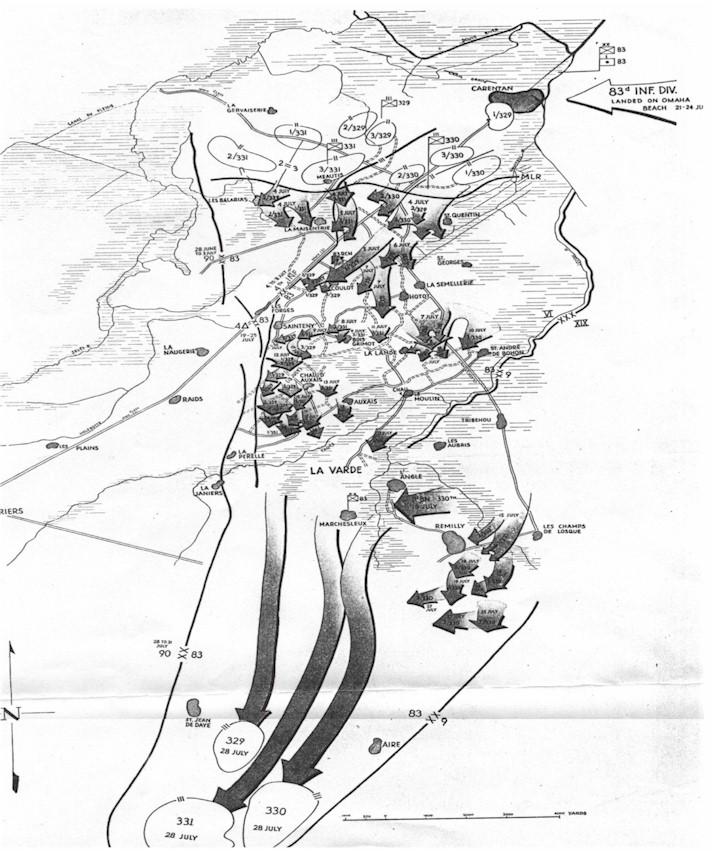
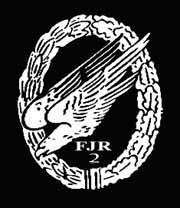 experienced before June 6, many of the young paratroops were not. For most of them the battle for Normandy would be there first (and last) action. During the D-day landings the 6th parachute Regiment was one of the first units to arrive on the scene to fight against the Americans. Heavy fighting from June 6-10 had wiped out the entire first battalion. By July 4th the remaining two battalions had set up defensive positions all along the Periers-St Lo highway -
waiting.
At 0445 the 83rd celebrated the 4th of July with a ten- minute artillery barrage. The 2nd and 3rd battalions of the 331st jumped off first, abreast of the 330th Infantry Regiment. Rolland Despres and his
machine gun squad were in the First Battalion, which was held in reserve, The assault against the Germans was slow and costly. The Germans knew the routes that the 83rd would have to take, and from concealed positions dug in beneath the hedgerows, they ranged in on the advancing GIs with mortars, artillery, and machine gun fire. Things went wrong almost immediately soon all hell broke loose. The supporting tanks ran over the telephone wires and communication was lost between headquarters and the assaulting regiments.
experienced before June 6, many of the young paratroops were not. For most of them the battle for Normandy would be there first (and last) action. During the D-day landings the 6th parachute Regiment was one of the first units to arrive on the scene to fight against the Americans. Heavy fighting from June 6-10 had wiped out the entire first battalion. By July 4th the remaining two battalions had set up defensive positions all along the Periers-St Lo highway -
waiting.
At 0445 the 83rd celebrated the 4th of July with a ten- minute artillery barrage. The 2nd and 3rd battalions of the 331st jumped off first, abreast of the 330th Infantry Regiment. Rolland Despres and his
machine gun squad were in the First Battalion, which was held in reserve, The assault against the Germans was slow and costly. The Germans knew the routes that the 83rd would have to take, and from concealed positions dug in beneath the hedgerows, they ranged in on the advancing GIs with mortars, artillery, and machine gun fire. Things went wrong almost immediately soon all hell broke loose. The supporting tanks ran over the telephone wires and communication was lost between headquarters and the assaulting regiments.
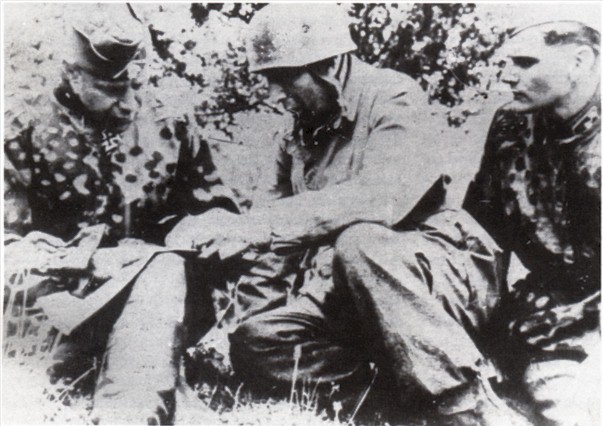 By 0700 Colonel Martin Barndollar CO of the 331st was killed in his Observation Post (OP) by a sniper. The 308th engineers attempting to clear paths through the minefields were systematically being picked off by rifle fire. Several tanks from the 746th were temporarily surrounded by German troops. The regiments advanced a mere 200 yards before the concentrated German mortar, artillery, and machinegun fire halted the attack. The dead and wounded littered the fields. With the attack halted, many of the troops filtered back to their original lines carrying the wounded. At this point in the war the Germans would not shoot infantrymen that were carrying wounded back to their lines. This humane act would change as the war progressed. Casualties were high especially among the Officers and NCO’s. 331st’s 1st battalion now committed to the attack lost all four of their platoon
leaders. After a frontline count of the men it revealed that the 331st was down to 300 men and the 330th about the same. Later in the evening Major von der Heydte Commanding Officer of the 6th Parachute regiment, returned all the medical personnel that his Paratroopers had captured that day along with a note to General Macon stating that he thought they might need them. Also, he asked that if the situation were ever reversed that the general would return the favor. The number of GIs killed, wounded or missing in combat that first day totaled more than 1,400 or about ten percent of the divisions strength. Although the 83rd had not accomplished it’s mission that day, General Collins had no alternative but to keep the press on. He ordered the attack to resume the next day. The 331st Infantry now under command of the executive officer Lieutenant Colonel William Long was assigned again to try again along the Carentan-Perrier highway. On July 5th the division jumped off on schedule. The attack fared no better than the previous day. Mortar, artillery, and concentrated machinegun fire kept the 83rd at bay. General Macon under extreme
By 0700 Colonel Martin Barndollar CO of the 331st was killed in his Observation Post (OP) by a sniper. The 308th engineers attempting to clear paths through the minefields were systematically being picked off by rifle fire. Several tanks from the 746th were temporarily surrounded by German troops. The regiments advanced a mere 200 yards before the concentrated German mortar, artillery, and machinegun fire halted the attack. The dead and wounded littered the fields. With the attack halted, many of the troops filtered back to their original lines carrying the wounded. At this point in the war the Germans would not shoot infantrymen that were carrying wounded back to their lines. This humane act would change as the war progressed. Casualties were high especially among the Officers and NCO’s. 331st’s 1st battalion now committed to the attack lost all four of their platoon
leaders. After a frontline count of the men it revealed that the 331st was down to 300 men and the 330th about the same. Later in the evening Major von der Heydte Commanding Officer of the 6th Parachute regiment, returned all the medical personnel that his Paratroopers had captured that day along with a note to General Macon stating that he thought they might need them. Also, he asked that if the situation were ever reversed that the general would return the favor. The number of GIs killed, wounded or missing in combat that first day totaled more than 1,400 or about ten percent of the divisions strength. Although the 83rd had not accomplished it’s mission that day, General Collins had no alternative but to keep the press on. He ordered the attack to resume the next day. The 331st Infantry now under command of the executive officer Lieutenant Colonel William Long was assigned again to try again along the Carentan-Perrier highway. On July 5th the division jumped off on schedule. The attack fared no better than the previous day. Mortar, artillery, and concentrated machinegun fire kept the 83rd at bay. General Macon under extreme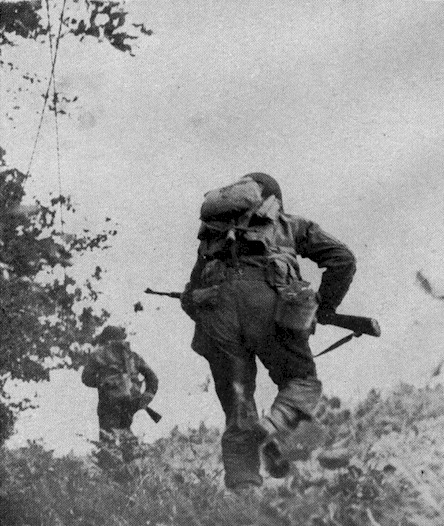 pressure from General Collins began exerting force on his subordinate commanders to push on the attack. By nightfall the balance of the 329th Infantry Regiment, which was held in reserve, entered the line and pushed through to capture the small hamlet of Coulot, about half way to Sainteny. This eased the pressure against the left of the line where the 330th had repelled repeated enemy counterattacks. The 330th had taken the highest number of casualties the day before. Uncoordinated attacks through the marshes had cost many men their lives. Then the Germans counterattacked. The German attempted to organize an armored attack using tanks. The 83rd’s field artillery battalions halted these tank-supported counterattacks. Meanwhile the 308th Engineers cleared their way through mine fields and booby traps to find the way through. At times they had to blast supply routes through the hedges. Tanks, tank destroyers and armored infantry aided in the attack. Casualties were heavy. The 83rd lost an additional 750 men on the second day of the offensive. Captured enemy prisoners confirmed that the 6th Parachute Regiment was reinforced with the 2nd SS Panzer Division’s troops. General Collins impatient with the progress of the 83rd then decided to commit the 4th Infantry Division into the assault. He told General Macon to concentrate his efforts on the left side of the
pressure from General Collins began exerting force on his subordinate commanders to push on the attack. By nightfall the balance of the 329th Infantry Regiment, which was held in reserve, entered the line and pushed through to capture the small hamlet of Coulot, about half way to Sainteny. This eased the pressure against the left of the line where the 330th had repelled repeated enemy counterattacks. The 330th had taken the highest number of casualties the day before. Uncoordinated attacks through the marshes had cost many men their lives. Then the Germans counterattacked. The German attempted to organize an armored attack using tanks. The 83rd’s field artillery battalions halted these tank-supported counterattacks. Meanwhile the 308th Engineers cleared their way through mine fields and booby traps to find the way through. At times they had to blast supply routes through the hedges. Tanks, tank destroyers and armored infantry aided in the attack. Casualties were heavy. The 83rd lost an additional 750 men on the second day of the offensive. Captured enemy prisoners confirmed that the 6th Parachute Regiment was reinforced with the 2nd SS Panzer Division’s troops. General Collins impatient with the progress of the 83rd then decided to commit the 4th Infantry Division into the assault. He told General Macon to concentrate his efforts on the left side of the
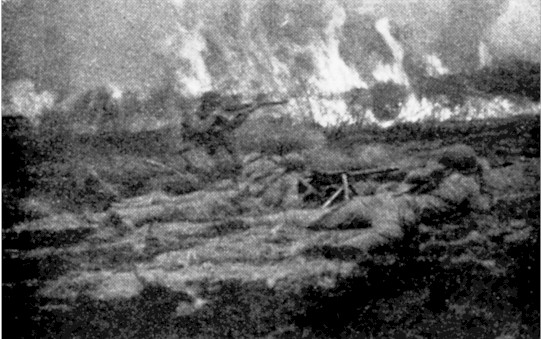 Carentan-Perriers road while the 12th infantry regiment passed through the lines to relieve them. Early in the Morning of the 6th of July the 12th Infantry Regiment of the 4th Division began relieving the 331st regiment. This would be a difficult relief due to the strong enemy artillery and mortar fire. When the 12th Infantry finally passed through and began their attack they met with the same strong resistance and the attack was halted for the day. General Collins frustrated at the lack of progress decided to try something different for the next day’s attack. Plans for a coordinated air and land assault on the German positions were made. General Collins coordinated with the 9th Air force to use it’s P-47 Thunderbolts to bomb and strafe the positions in front of the VII Corps. However, by the next morning a drizzling rain would disrupt these plans and the divisions would have to go it alone without air support. At 0845 on the morning of July 7th the 22nd infantry passed through the 331st regiment and began it’s attack. The
Carentan-Perriers road while the 12th infantry regiment passed through the lines to relieve them. Early in the Morning of the 6th of July the 12th Infantry Regiment of the 4th Division began relieving the 331st regiment. This would be a difficult relief due to the strong enemy artillery and mortar fire. When the 12th Infantry finally passed through and began their attack they met with the same strong resistance and the attack was halted for the day. General Collins frustrated at the lack of progress decided to try something different for the next day’s attack. Plans for a coordinated air and land assault on the German positions were made. General Collins coordinated with the 9th Air force to use it’s P-47 Thunderbolts to bomb and strafe the positions in front of the VII Corps. However, by the next morning a drizzling rain would disrupt these plans and the divisions would have to go it alone without air support. At 0845 on the morning of July 7th the 22nd infantry passed through the 331st regiment and began it’s attack. The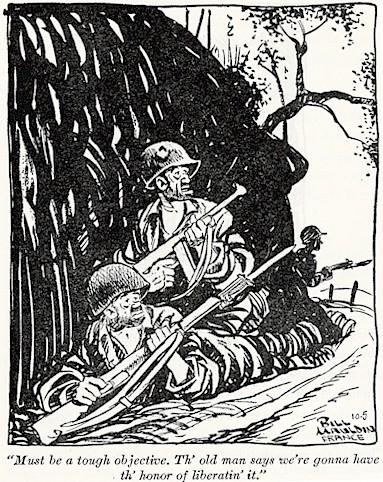 331st withdrew to an area northwest of La Sudotterie. After regrouping the regiment joined the battle to continue it’s objective to take Sainteny and the high ground to the East. At 1700 hours they began. The 1st and 3rd battalions of the 331st Infantry attacked with two companies of tanks and tank destroyers from the 70th and the 801st they pushed on to take Hotot. Strong enemy counter-attacks continued all morning, but were stopped by concentrated artillery, bazooka, and tank fire. Sometime during this see saw fighting period Uncle Rolland told my father that the Germans captured him, along with a medic. The lines were so confusing he said that you couldn't tell which line was which. Rolland soon evaded his captors by jumping off a truck and
running back to his own lines.
The 331st advanced toward the Taute River. 8 July, the GI’s of the 331st fought through hedgerows to the village of Auxais. They continued their advance towards Sainteny and the Taute River, slugging it out with the German tanks and dug in troops. Hedgerow by hedgerow they pushed on, taking heavy casualties. On July 9th Colonel James Bender assumed command of the 331st regiment. The 2nd Battalion of the 331st finally captured the elusive Sainteny after a sustained attack supported by fighter-bombers. On the 10th of July the 331st repelled several counterattacks but held on to Sainteny.
2nd battalion commander Lt. Col. James Faber was killed by a direct hit by a German 88 shell. The following day the 331st moved out to seize the town of Marchesieux but failed after meeting more heavy resistance. The new regimental commander Col Bender was killed after only in command for two days as an 88 shell hit his command jeep. Progress was extremely slow over the next few days. Resistance from tanks supported with small infantry units which were well dug in and camouflaged. Reinforced dugouts with supporting heavy machine gun fire caused more heavy casualties. On the morning of the 13th Colonel Robert H. York would assume command of the beleaguered 331st. The Regiment resumed the attack. Elements of the third battalion were cut off from the regiment by a German counterattack of tanks and infantry. The isolated troops had to sit tight for two days until the Regiment could relieve them. The division finally came to a stop at a causeway leading to La Varde. On the 14th of July the 330th Regiment crossed the Tribehou causeway and joined other units attacking east of the Taute River. On the 15th of July the 83rd Division and the 4th division passed to control of the VIII Corps in a front-wide reorganization. While terrain and the enemy had halted the drive of the VII Corps, the attack did achieve some of it’s goals. By moving the front several miles south of Carentan it stabilized
the area and prevented the Germans from shelling the town and the vital
crossroads. Further it prevented the Germans from launching a counterattack in
this area considered the weakest on the entire front and had inflicted serious
losses on the Germans, losses they could not replace.
331st withdrew to an area northwest of La Sudotterie. After regrouping the regiment joined the battle to continue it’s objective to take Sainteny and the high ground to the East. At 1700 hours they began. The 1st and 3rd battalions of the 331st Infantry attacked with two companies of tanks and tank destroyers from the 70th and the 801st they pushed on to take Hotot. Strong enemy counter-attacks continued all morning, but were stopped by concentrated artillery, bazooka, and tank fire. Sometime during this see saw fighting period Uncle Rolland told my father that the Germans captured him, along with a medic. The lines were so confusing he said that you couldn't tell which line was which. Rolland soon evaded his captors by jumping off a truck and
running back to his own lines.
The 331st advanced toward the Taute River. 8 July, the GI’s of the 331st fought through hedgerows to the village of Auxais. They continued their advance towards Sainteny and the Taute River, slugging it out with the German tanks and dug in troops. Hedgerow by hedgerow they pushed on, taking heavy casualties. On July 9th Colonel James Bender assumed command of the 331st regiment. The 2nd Battalion of the 331st finally captured the elusive Sainteny after a sustained attack supported by fighter-bombers. On the 10th of July the 331st repelled several counterattacks but held on to Sainteny.
2nd battalion commander Lt. Col. James Faber was killed by a direct hit by a German 88 shell. The following day the 331st moved out to seize the town of Marchesieux but failed after meeting more heavy resistance. The new regimental commander Col Bender was killed after only in command for two days as an 88 shell hit his command jeep. Progress was extremely slow over the next few days. Resistance from tanks supported with small infantry units which were well dug in and camouflaged. Reinforced dugouts with supporting heavy machine gun fire caused more heavy casualties. On the morning of the 13th Colonel Robert H. York would assume command of the beleaguered 331st. The Regiment resumed the attack. Elements of the third battalion were cut off from the regiment by a German counterattack of tanks and infantry. The isolated troops had to sit tight for two days until the Regiment could relieve them. The division finally came to a stop at a causeway leading to La Varde. On the 14th of July the 330th Regiment crossed the Tribehou causeway and joined other units attacking east of the Taute River. On the 15th of July the 83rd Division and the 4th division passed to control of the VIII Corps in a front-wide reorganization. While terrain and the enemy had halted the drive of the VII Corps, the attack did achieve some of it’s goals. By moving the front several miles south of Carentan it stabilized
the area and prevented the Germans from shelling the town and the vital
crossroads. Further it prevented the Germans from launching a counterattack in
this area considered the weakest on the entire front and had inflicted serious
losses on the Germans, losses they could not replace.
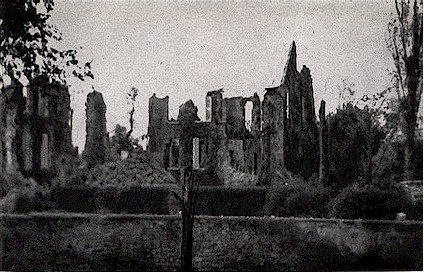
The Swamps of LaVarde
On the 17th of July the 83rd made one final push to cross the swamps of the La Varde and take the higher ground on the La Varde peninsula. The Taute River at this point was only 15 feet wide, and two feet deep with a mud bottom of approximately another 1 foot. However, the marsh surrounding the area was over a mile in length. The terrain was completely open with no cover for the troops and only a narrow causeway leading across. At the end of the causeway was a demolished bridge which led into the peninsula. The entire area was under heavy German fire. General Macon decide to launch the attack at 1800, this would give the engineers five hours to repair the bridge before darkness set in. By late afternoon of the 17th the 330th Regiment attacked the peninsula from the eastern bank of the river. This attack was broken up by concentrated machine gun fire. The 329th also launched a diversionary assault on the western side of the peninsula this attack too was blunted after 13 casualties. At 1830 hours the 1st battalion of the 331st launched an attack across the swamp. By using prefabricated foot bridges the infantry was able to cross the swamp and secure a weak bridgehead. This bridgehead was unable to hold on and was forced back. On the 19th of July the 331st tried again. Against surprisingly light enemy fire the regiment was again able to establish a bridgehead across the Taute. The engineer immediately went to work building a bailey bridge across the river. However due to a lack of foresight the charges of explosives routinely installed on the bridges were not removed as a result a 88 shell hit the bridge and the explosives and the bridge disappeared in a instant. Afterwards the Germans counterattacked and the troops retreated back across the swamp. The failure of the 83rd to take the peninsula was a direct result of the loss of men from the 83rd. The division had sustained so many casualties that the remaining troops and replacements were ineffective. Generals Bradley and Middleton realizing this refrained from using the 83rd in any future attack and allowed them a few days to reorganize and train their men.
OPERATION COBRA
Began on the morning of 25 July. Over 1,500 medium and heavy bombers dropped 5,000 tons of bombs in front of the American lines. The VII Corps under General Collins launched a coordinated attack all along the front. The 83rd division along with several other divisions exploited the confusion and disorganization the bombing had caused the enemy. On 26 July, after heavy hedgerow fighting the 83rd finally crossed the Taute River. The 83rd with assistance from the 8th division finally cut the Saint Lo-Periers road. On the 28th the 330th regiment was finally able to link back up with it’s parent unit. German resistance melted away, and Operation Cobra was a huge success. After the 83rd had reached their objectives they took a brief rest and then prepared for their next campaign in Brittany.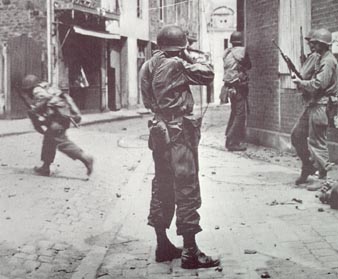
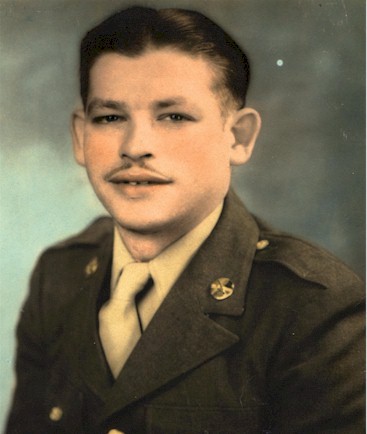 Rolland
Despres: Homepage
Rolland
Despres: Homepage They
Served with Honor: Homepage
They
Served with Honor: Homepage